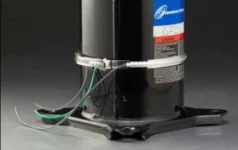https://www.acfurnaceparts.com/Service Manuals/13ACD.pdf
Per the linked document, a crankcase heater is optional.
My inspection was inconclusive - Rhino conduit containing the three power conductors (240 Vac) runs alongside a small BN cable which almost certainly carries the low-voltage (24 Vac) control conductors. The Rhino conduit enters and exits the disconnect switch on the outside wall of the house. The run of control cable is continuous.
Per Pg 12 of the linked document, the wiring to the crankcase heater (if present) is all internal - I'm not curious enough to start taking things apart to confirm the presence of a heater.
If there is a crankcase heater, it is thermostatically controlled. I will leave the breaker on this coming autumn, and check for current again. Once it gets cold out, the heater, if present, should run. This is only for my own curiosity, though.
After determining whether or not there's a crankcase heater, I'll continue to flip the breaker off after cooling is no longer required, and will turn it on again at least 24 hours before I think we'll want to run the AC.
Doing so does no harm, and might do some good.
Thanks, everyone, for your contributions.

